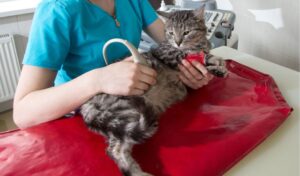Is Feline Leukemia Contagious to Humans?

Feline leukemia, also known as FeLV, is a viral infection that affects cats worldwide. It is one of the most common infectious diseases in cats, and it can have serious implications on a cat’s health. One of the common concerns pet owners have is whether FeLV is contagious to humans. In this article, we will discuss FeLV in detail, and answer the question: is feline leukemia contagious to humans?
Understanding Feline Leukemia
Feline leukemia virus (FeLV) is a common infectious disease that affects cats all over the world. It is a retrovirus, which means that it inserts its genetic material into the DNA of the cells it infects. This causes a variety of health problems for cats, including a weakened immune system, anemia, and cancer. Unfortunately, FeLV is also one of the leading causes of death in cats.
The virus is transmitted primarily through close contact with an infected cat. This can include sharing food or water bowls, grooming each other, and mating. Kittens can also acquire the infection from their mother while still in the womb or while nursing. It is important to note that not all cats that are exposed to the virus will become infected. The risk of transmission depends on a variety of factors, including the age and health of the cat, and the strain of the virus.
One of the reasons that FeLV is so dangerous is that it suppresses the immune system. This means that infected cats are more susceptible to other infections and diseases. They may also have difficulty fighting off infections that would not be a problem for a healthy cat. As a result, cats with FeLV are more likely to develop secondary infections or complications from illnesses that they would normally be able to handle.
Treatment
Unfortunately, there is no cure for FeLV. Once a cat becomes infected, it will carry the virus for the rest of their life. The average lifespan of a cat with FeLV can vary depending on the stage of the infection and the cat’s overall health. Cats with FeLV may live for several years, but many succumb to the disease within a few years of diagnosis (Median age is 2.5 years).
Proper veterinary care and management can help extend the lifespan and improve the quality of life for cats with FeLV.

Feline Leukemia Symptoms
The symptoms of FeLV vary depending on the stage of the infection. The virus can be divided into three stages:
- Primary infection: During the first few weeks after exposure, a cat may experience a transient fever, loss of appetite, and lethargy. The virus then either gets eliminated by the immune system or remains in the bone marrow and lymph nodes.
- Latent infection: A cat that does not clear the virus in the primary infection may become a carrier and remain in this stage for months or years. During this time, the cat may appear healthy and show no symptoms. However, the virus can be reactivated and lead to secondary infections.
- Progressive infection: If the virus becomes reactivated, it can lead to a progressive infection that can cause a range of symptoms. These include:
- Anemia
- Lethargy and weakness
- Loss of appetite and weight loss
- Persistent fever
- Swollen lymph nodes
- Diarrhea
- Vomiting
- Respiratory infections
- Skin and eye infections
- Cancerous tumors
Cats with progressive FeLV infections may also develop neurological symptoms like seizures and behavioral changes. These symptoms can be fatal if left untreated.
It is important to note that the symptoms of FeLV can be similar to those of other illnesses, so a definitive diagnosis can only be made through blood tests. If you suspect that your cat may have FeLV, it is important to take them to a veterinarian for a proper diagnosis and treatment.
Is Feline Leukemia Contagious to Humans?
Now that we understand Feline Leukemia better, lets discuss whether it is contagious for humans.
According to research, the feline leukemia virus cannot be transmitted to humans. This is because the virus is highly species-specific like most cat diseases, and cannot survive or replicate outside the feline body. Therefore, humans cannot contract the virus by coming into contact with an infected cat or their bodily fluids.
The virus does not live long outside of a cat host, so spreading FeLV to other cats via human clothing and hands is also unlikely. Although it can still spread through other means (e.g. direct contact).

Is Feline Leukemia Contagious to Other Cats?
Yes, Feline Leukemia Virus (FeLV) is highly contagious to other cats. The virus is shed in high concentrations in the saliva, urine, feces, and milk of infected cats, making it easy for other cats to become infected through direct contact with an infected cat or through exposure to contaminated objects like food or water bowls, litter boxes, and grooming tools.
FeLV is most commonly spread through social behavior like grooming, mating, and sharing food and water bowls. It can also be transmitted from an infected mother cat to her kittens during pregnancy, birth, or through nursing.
Preventing the Spread of FeLV in Cats
The best way to prevent the spread of FeLV is to ensure that all cats are tested for the virus before they are introduced to a new household or colony. Cats who test positive for FeLV should be separated from other cats to prevent the virus from spreading. It is also important to regularly clean and disinfect any shared objects like food and water bowls, litter boxes, and grooming tools.
Vaccines are available to help protect cats against FeLV, but they are not 100% effective. It is still possible for vaccinated cats to contract the virus, so it is important to take other preventative measures as well.
If you have multiple cats, it is important to monitor them closely for any signs of FeLV. Early detection and treatment can help improve the chances of a positive outcome.
Conclusion
In conclusion, Feline Leukemia is a serious viral infection that affects cats worldwide. FeLV is highly contagious among cats, but fortunately it cannot be transmitted to humans. The virus is transmitted primarily through close contact with an infected cat, and symptoms can range from a transient fever to cancerous tumors.
The best way to prevent the spread of FeLV is to ensure that all cats are tested for the virus before they are introduced to a new household or colony, and vaccinated if possible. Owners should also regularly clean and disinfect any shared objects to prevent the spread of the virus. With proper preventative measures and care, the impact of FeLV can be minimized, and their quality of life improved.


